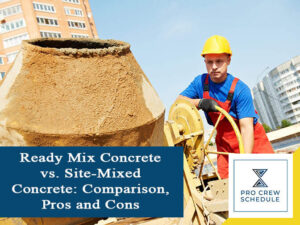Concrete is one of the most extensively used construction materials. It is manufactured using natural ingredients and is considered recyclable and environmentally friendly. It is made up of three basic components: aggregates, water and Portland cement. There are two main types of cement used in the construction industry – site-mixed concrete and ready-mixed concrete. Choosing the most suitable type of cement for construction projects is extremely vital. While both types are sustainable for concrete construction, one might be more beneficial compare to the other varying on project conditions.
For this blog, we are to compare both ready-mix and site-mixed concrete, including its pros and cons.
Why is a Good Concrete Mix Essential?
A good concrete mix creates a foundation of a sound and firm infrastructure. It involves a streamline of the preparation process wherein a mix of materials creates the required durability and strength for the concrete structure. Because each ingredient in the mix has consisted of distinctive properties, it is challenging to develop a better concrete mix. All components must be tested first to determine the physical properties of it. The bearing capacity of the current project location is also another factor.
Concrete Mix Key Attributes
A concrete mix is like a chef’s excellent recipe. Apart from the 3 essential concrete components, it is also made from other cementitious materials or chemical admixtures. Several concrete mixes usually entrapped air by utilizing air-entraining cement or admixtures. Concrete mixes should also have chemical components used to retard, accelerate or improve manageability. With chemical components, concrete mixes can minimize water quantities, increases its strength and switching its concrete properties.
That is why, choosing the best concrete mix is an important task that needs to consider both for placement requirements and costs while providing an integral product and great aesthetic. For concrete contractors, one crucial thing that needs to prioritize is using builder trends software. This advanced tool is designed for scheduling and project management purposes which make work well-organized.
Furthermore, a great concrete mix must consider the following:
1. Water-Cement Ratio
The concrete mix has the W/C ratio which defines the ratio and relationship between the weight of water and weight of cement being added to the mix. These characteristics have a linear and direct relationship with the mix strength.
2. Heat-Release
A concrete mix must also consider heat being unconfined under chemical reactions. As a result, it will fade away a considerable rate without producing shrinkage or cracks.
3. Grade designation
The concrete strength should be measured as being subject to test. Execution of tests usually done after curing any curing medium. The selection of concrete grade varies on its usage.
4. Aggregate size
All aggregates should be quality sized before use. Aggregates are a crucial component for every mix and it is dependent on the physical properties required for the design.
5. Workability
The workability of the concrete mix is the property aspect that identifies the mix capacity to consolidate and placed correctly. By doing so, it allows finishing a product without needing any segregation.
6. Consistency
This property identifies the slump of the concrete mixes and their mobility. This particular characteristic is typically measured by the slump. The greater slump values will be, the bigger and more manageable the mobility will be obtained.
7. Durability
An excellent concrete mix will definitely provide you with concrete that could endure extreme weather conditions and recurring changes without any signs of decay. The more durable concrete is, the more resilient it will be to weather variations such as drying, wetting, freezing, and heating.
8. Density
Concrete mixes can also be categorized for several applications like radiation protection, counterweights, resistance and insulation. Density is one of the essential characteristics of the concrete mix and the most popular property.
Ready-Mix Concrete vs. Site-Mix Concrete
Several factors will be considered to outline the comparison between these 2 types of concrete. The factors include time, equipment, distribution, recommended application, waste, storage equipment, workforce, quality, material takeoff and other vital considerations. Using a crew schedule software is also a critical factor to consider. With this software, monitoring a streamline of processes is faster and easier. Concrete contractors no need to track everything manually.
1. Ready-Mix Concrete
Ready-mix concrete is commonly manufactured from a factory and will be delivered to the construction site while in a plastic or unhardened state, ready for use. This type of concrete is typically expressed in cubic meters and is sold by volume. Concrete guarantees higher sustainability and durability. The mixture formed is higher in quality and more precise as expert suppliers carry out the work.
Time: Less-time consuming and delivered ready to use
Distribution: can be delivered to numerous sites within a project; distribution tracking is easily done using a construction scheduling software
Equipment: Equipment isn’t required at the construction site
Storage Requirements: additional storage space isn’t necessary for raw materials
Recommended Application: High-rise structures
Waste: The material waste at the job site is minimal
Quality: the quality is consistent due to programmed and controlled environment
Material takeoff: it can be measured as a single item
Workforce: only skilled laborers are only required to compact and pour concrete
Space: suitable access is required for concrete mixer trucks
Batch Size: huge amounts of concrete can be delivered anytime and the delivery process can be efficiently monitored using a builder software
Site Location: if the plant is located too far from the concrete site, retardants and admixtures are required for concrete to prevent the setting
Pros:
· Concrete is typically batched within factor conditions to maintain the consistency of the quality material
· Concrete will be supplied in transit mixer so lesser space is required onsite
· Material wastage onsite is negligible as batched as the products
· Proper mixing and better handling practice will help to reduce the consumption of cement by 12%
· The concrete mixed is utilized with high versatility
· Cement is saved and the dust is reduced as the ready-mix concrete making use of bulk concrete
· More durable structure is achieved; thus, service life tend to increase
Cons:
· Traffic during the transit could result in setting up the concrete. There might be additional admixtures needed once there’s a delay. The greater problem comes when there is unexpected traffic.
· The transit time from the start of concrete preparation until the delivery site will eventually result in a loss of workability. At the site, QA/QC engineers check the workability through slump tests before having it for construction.
· The placing arrangement and formwork should be prepared in advance in the area as the ready-mix concrete can be handled in larger amounts
· There might be quality concerns because of the continuous need of admixtures
· Transportation costs tend to increase most of the time
2. Site-Mix Concrete
As the name implies, it is a volumetric concrete that is usually prepared at the site. There will be concrete components involved and this will be mixed in specific ratios to achieve the desired strength. This particular method requires utilizing formulas to identify the number of steps and amount of materials to acquire desired consistency. Concrete workers have to be meticulous and careful with the standard proportions of the materials to avoid quality conflicts in the concrete. To be more precise with the standard proportions, using a task scheduler software is very useful. The tool allows concrete experts to manage further and supervise all implemented methods and strategies while the work is going on.
Time: the process seems slower because of various steps and setting time and formulas are involved
Distribution: concrete is mixed at the scheduled point of use to prevent contamination
Equipment: to make concrete on-site, a weigh batch mixer is necessary.
Storage Requirements: controlled storage space is required to protect and manage materials like aggregates and cement
Recommended Application: Low-rise structures
Waste: during mixing and storing, material loss usually happens
Quality: continual supervision is meant for consistency among batches
Material takeoff: the materials are estimated separately, and the purchase is planned individually
Workforce: it requires several hours to prepare concrete on the jobsite
Space: large space is required for batch mixers and material storage
Batch Size: mixing vast amounts of concrete on construction site is difficult
Site Location: requires transportation for mixing equipment and materials to the construction site
Pros:
· With well-organized supervision, except for high-quality and economical concrete
· A small quantity of batch can be required and produced without varying from an external agency in terms of scheduled concrete works
· The design can be rather optimized per strength result and projects managers can do value engineering to save money
· There is no restriction with order quantity
· The need to rely on external agencies for finishing concrete works is not necessary
· Site-Mix concrete is more affordable than ready-mix for about 20%
Cons:
· More space is required for stocking materials
· Site logistics are needed to be taken care of
· Wastage of used materials as well as periodic reconciliation are to be monitored regularly
· Qualified staff on-site should supervise concrete production
Key Takeaways
To conclude, ready-mix concrete is usually better for most construction projects despite the increasing costs. It offers a much higher quality, including a variation between batches during concrete preparation in the plant environment. One key factor is the current location of the project because transportation requirements initially determine what type of concrete is preferable for the project. Additionally, ready-mix concrete is typically recommended for large-scale projects where high volume is required. Moreover, site mixing is a better option for small-time construction projects like renovation where concrete volume is smaller.








1 thought on “Ready Mix Concrete vs. Site-Mixed Concrete: Comparison, Pros and Cons”
Thanks for very useful informayions.
BR
Mahesh